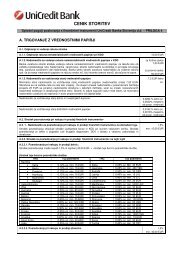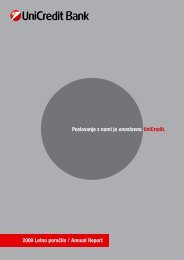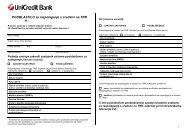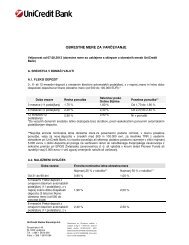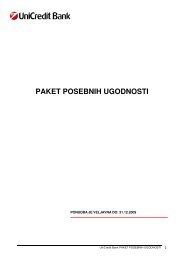26 September 2013 <strong>Economics</strong> & FI/FX <strong>Research</strong><strong>Weekly</strong> <strong>Focus</strong>Global business sentiment – the trend keeps heading northWhat has already been indicated by this week's readings should be confirmed next week bythe final round of global business sentiment figures: 1. <strong>The</strong> overall trend continues to headnorth, indicating that the global economy keeps recovering – albeit at a moderate pace;2. Following the previous spurt, manufacturing (sentiment) is taking a breather (and nothingmore than a breather) in Europe and the US, while its services counterpart keeps advancingin most countries, and 3. China's manufacturing sentiment is improving again, thus helping tostop the decoupling of the overall Emerging Market figure from the Developed World numberseen over recent months.In the eurozone, the pattern seen in September flash PMI readings for the EMU, Germanyand France should not only be confirmed next week but will most likely also show up in Italy,where the September figures will be published next Tuesday. We expect the CompositePMI to advance further, solely driven by the services component (up from 48.8 to 49.5). Itsmanufacturing counterpart, however, is expected to edge down slightly (51.0 versus 51.3).This would be the first decline following five monthly increases which pushed the index abovethe important 50 threshold this summer – but will be nothing more than just a breather in anotherwise well-established upward trend as indicated by the forward-looking orders-toinventory-ratio.Within five months, the new orders subcomponent even jumped by 12.2 pointsto 53.3 (see chart next page), while the inventory sub-index declined to 46.1 – the lowest levelsince August 2010! Beyond short-term fluctuations, industrial activity should, therefore,improve further. Even with the moderate decline in September, the manufacturing PMI impliesa broad stabilization in industrial output in the current quarter after a pronounced 1.0% qoqdecline in 2Q13. This would be consistent with our forecast of a flat GDP reading for 3Q13.Outside Europe, the sentiment trend is also clearly heading north, first and foremost in the US.Sentiment among businesses across the country continues to be supported by animproving economic outlook – at home and abroad. But given the surge over recent monthscatapulting readings up to multi-year highs of 55.7 (manufacturing) and 58.6 (services) inAugust, it would be foolhardy to expect the indicators to improve each and every month. Thisis even more true at times of increasing concerns about the upcoming fiscal policy fight (debtceiling) and uncertainties about implementation of the new health care legislation, whichkicks-in on 1 October. We therefore expect both US ISM barometers to take a breather andease temporarily – with the manufacturing ISM most likely down 1.2 pts to 54.5.Business sentiment in Asia is also brightening (again). Japan took its breather already in July,when the spectacular advance of the Markit/JMMA manufacturing PMI of more than 7 ptssince the start of the year was interrupted. But the 1.6 pts decline was already matched inAugust, and the September reading (out next Monday) is expected to advance to a 2½ yearhigh at 52½. This is at least indicated by the improved Shoko Chukin small firm sentiment thatedged up in September. Its October outlook reading, if realized, would be the highest levelsince November 2006! <strong>The</strong> Tankan outlook component was promising as well, indicating thatthe recovery momentum of the Japanese economy remains intact.At the same time, there is growing evidence that the growth slowdown in industrial (and thuseconomic) activity in Emerging Asia may have run its course, at least in China. Following theshift in economic policy, the lagged effects of the credit surge seen earlier this year andimproving external demand, we expect the official NBS manufacturing PMI (to be publishednext Monday) to rise by 0.5 pts to 51.5, an improvement already signaled by this week's flashreading of its Markit/HSBC counterpart. An improving manufacturing sentiment in China(and maybe other Emerging Asian countries as well given first hints of improving externaldemand/orders) could prevent the (sentiment) divergence between Emerging Markets and theDeveloped World seen over recent months to develop further (see right chart next page).<strong>UniCredit</strong> <strong>Research</strong> page 12 See last pages for disclaimer.
26 September 2013 <strong>Economics</strong> & FI/FX <strong>Research</strong><strong>Weekly</strong> <strong>Focus</strong>ITALY: BUSINESS SENTIMENT CLEARLY TRENDING NORTHSENTIMENT IN EMERGING ASIA IS STABILIZING7065605550605550Manufacturing PMI454540353025Manufacturing PMINew orders component4035G-4 (US, EMU, UK, Japan)BRICEmerging Asia20Aug-00 Oct-02 Dec-04 Feb-07 Apr-09 Jun-11 Aug-1330Jan-08 Jan-09 Jan-10 Jan-11 Jan-12 Jan-13 Jan-14Source: BLS, Department of Labor, <strong>UniCredit</strong> <strong>Research</strong>US: Higher job gains unlikely to trigger October Fed action<strong>The</strong> lackluster August employment report was one of those factors that led the Fed to delaytapering – even if FOMC members' deeper-than-generally-appreciated concern about thedebt ceiling discussion was the tipping point. In any case, investors are eager to see whetherthe September employment report, to be released on Friday of next week, will show fasteremployment growth that brings the US economy closer to the sustainable labor marketimprovement that the Fed wants to see before starting to reduce its bond purchases. We thinkthat payroll gains accelerated further in September to 190,000 from 169,000 seen in Augustand a mere 104,000 in July. Initial jobless claims, the most timely labor market indicator, evendropped to a 7½ year-low in early September. And while issues with seasonal factors mayhave exaggerated the decline, the downward trend unequivocally signals that the pace oflayoffs has continued to improve. Hiring activity, on the other hand, remains more of aconcern. Companies might have been even more cautious due to the looming fiscal deficitbattle and the uncertainties about the details and start of Obamacare. Our forecast, whichlooks for payroll gains to return to their 1H13 monthly average, implies that the weaknessseen in the summer is a temporary breather rather than the start of a downward trend. But willit be enough to prompt the Fed to announce lower monthly asset purchases at the upcomingmeeting? We doubt it. Atlanta Fed President Lockhart, a centrist whose views tend to representthe Fed's consensus, told the Wall Street Journal that he does not think there will be anaccumulation of enough evidence to dramatically change the picture of an economy definedby "ambiguous" economic data and facing government budget showdowns in coming weeks. 2Forecasting short-term developments of the unemployment rate continues to remain more anart rather than a science. Despite modest employment gains, the jobless rate fell to 7.3% inApril, the lowest since late 2008. <strong>The</strong> decline was once again triggered by a decline in theparticipation rate, which fell in August to 63.2%, the lowest level since 1978! According to ourcalculations, the actual participation rate is 1.4pp below its "fair" value of 64.6%, i.e. the levelwarranted by demographic developments. With the participation rate at this fair level, theunemployment rate would stand at 9.3% (see right chart below). We continue to expect thatfrustrated people will eventually return to the labor force once a pick-up in hiring activityimproves overall jobs prospects. That will lift the participation rate and slow the decline in thejobless rate – or even partly reverse the latest downward moves. But this did, most likely, nothappen this September. Accordingly, we expect that the jobless rate stabilized at 7.3%.2 Two Fed Officials Stay Put on Bond Buys, Wall Street Journal, 24 September 2013.<strong>UniCredit</strong> <strong>Research</strong> page 13 See last pages for disclaimer.



